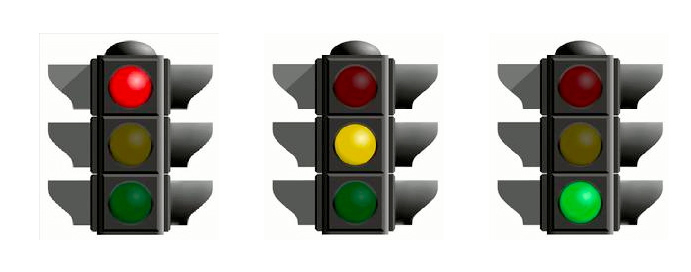Experiencing aches and pains after starting or increasing an exercise program? You’ve probably asked yourself the following questions:
- “Can I work through the discomfort I feel?”
- “Do I need to rest or adjust what I am doing?”
- “Do I need to seek additional help?”
[box size=”large” align=”center”]
A simple way to assess the situation is to simply put a finger on where you feel the discomfort, then follow these “stop light guidelines” :
[/box]
 If you start rubbing a broad area of a muscle with spread fingers or a hand, then a likely cause is simply delayed onset muscle soreness (“DOMS”). DOMS is the common & expected soreness in muscle when they are asked to do more work than they are accustomed to doing. This is a “Green Light” situation, you are probably ok to continue with your exercise routine, but you may want to add a bit more emphasis to your post workout recovery strategy.
If you start rubbing a broad area of a muscle with spread fingers or a hand, then a likely cause is simply delayed onset muscle soreness (“DOMS”). DOMS is the common & expected soreness in muscle when they are asked to do more work than they are accustomed to doing. This is a “Green Light” situation, you are probably ok to continue with your exercise routine, but you may want to add a bit more emphasis to your post workout recovery strategy.
 If you point to a specific spot or can put your one or two finger tips directly on the painful area, and that area is where a tendon attaches to bone, you have a “Yellow Light” situation. You are probably ok to continue but need to modify the F.I.T (frequency, intensity & total time) of your workout. Some tissue damage is beginning to occur at a level the body cannot fully repair during the recovery cycle. This situation also suggests that flaws in exercise form may be causing excessive strain in certain areas, so refinement of form may be needed. Backing off a little and making adjustments should be able to get you back on track.
If you point to a specific spot or can put your one or two finger tips directly on the painful area, and that area is where a tendon attaches to bone, you have a “Yellow Light” situation. You are probably ok to continue but need to modify the F.I.T (frequency, intensity & total time) of your workout. Some tissue damage is beginning to occur at a level the body cannot fully repair during the recovery cycle. This situation also suggests that flaws in exercise form may be causing excessive strain in certain areas, so refinement of form may be needed. Backing off a little and making adjustments should be able to get you back on track.
 If you point to an area that is within a joint, a place where the pain seems to have a fairly specific location, but it is too deep to find & touch, then this is a “Red Light” situation. These are cases where it is best to seek some professional help or assessment before proceeding further. If the pain is in joints and potentially causing injury to joint surfaces or cartilage, then the situation needs to be addressed. Cartilage does not have the ability to regenerate or heal like muscle or tendon. It is always better to be safe than sorry in these situations to avoid permanent tissue damage.
If you point to an area that is within a joint, a place where the pain seems to have a fairly specific location, but it is too deep to find & touch, then this is a “Red Light” situation. These are cases where it is best to seek some professional help or assessment before proceeding further. If the pain is in joints and potentially causing injury to joint surfaces or cartilage, then the situation needs to be addressed. Cartilage does not have the ability to regenerate or heal like muscle or tendon. It is always better to be safe than sorry in these situations to avoid permanent tissue damage.
Other basic guidelines to seeking help include:
- Pain that does not change with 2-3 days of rest
- Pain that lasts for greater than 2 weeks
- Pain that is severe enough to create an unavoidable change in your exercise form or technique
2 Week rule of thumb:
if any specific issue lasts longer than 2 weeks, it gets bumped up in the color progression.
2 weeks of green becomes yellow
2 more weeks of yellow becomes red
Change in Gait:
Green light: No change, maybe just feel it is harder or more work
Yellow light: You feel Something Not Right, your friends can tell something a little off if you ask them, but can’t specify it.
Red light: Obvious Change in your running form, anyone can see it
These are simple guidelines, but hopefully give a basic starting point. If in doubt, ask for help! We want everyone to be successful in taking care of themselves.
[xyz-ihs snippet=”bmsservices”]
[xyz-ihs snippet=”weeeklyworkoutad”]

